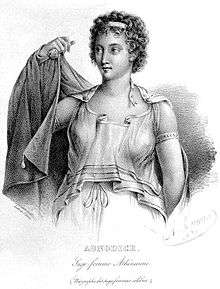Agnodice
| Agnodice | |
|---|---|
 Agnodice in her disguise as a male physician, imagined here not as lifting her tunic to reveal her true sex, but as opening her outer garment to show that she has breasts. | |
| Born | |
| Nationality | Greek |
| Occupation | Physician |
| Era | Classical Greece |
Agnodice or Agnodike (Ancient Greek: Ἀγνοδίκη, Greek pronunciation: [aŋnodíkɛː] c. 4th century BCE) is a legendary figure credited as the first female midwife or physician in ancient Athens. Her story is told by the Roman author Gaius Julius Hyginus in his Fabulae. Agnodice is not generally believed to be a historical figure, but her story has been frequently deployed as a precedent for women practising midwifery or medicine.
According to Hyginus, Agnodice studied medicine under Herophilus, and worked as a physician in her home city of Athens disguised as a man, because women at the time were forbidden from practising medicine. As her popularity with female patients grew, rival physicians accused her of seducing the women of Athens. She was tried, and revealed her sex to the jury by lifting her tunic. Accused of illegally practising medicine as a woman, she was defended by the women of Athens who praised her for her effective treatments. She was acquitted, and the law against female physicians in Athens was revoked.
Life story
Hyginus wrote that Agnodice lived in ancient Athens, where at the time women were forbidden from studying medicine. In order to learn medicine, she disguised herself as a man, cutting her hair short, and studied under Herophilus in Alexandria. Having trained as a physician, Agnodice tried to assist women in labour, who were ashamed of, or blatantly refused to consult male practitioners.[1] In one case, Agnodice therefore revealed her sex and was permitted to treat the woman. Other doctors, growing jealous of Agnodice's success, accused her of seducing her patients. On trial before the Areopagus, Agnodice once again lifted her clothes, revealing that she was a woman. She was then charged with breaking the law which forbade women from practising medicine, but was defended by the wives of important Athenians whom she had treated. In response to this, the law was changed to allow women to practise medicine.[2]
Hyginus describes Agnodice as an obstetrix. It is difficult to know how to translate this into English. Sarah Pomeroy has rendered it as "obstetrician", arguing that midwives existed in Athens in Agnodice's day but that Agnodice was distinguished by her formal education in medicine. However, Helen King notes that there was no "formal licensing system" for medics in the ancient world, and that it is anachronistic to divide ancient healers into the distinct categories of "midwife" and "obstetrician".[3]
Historicity
Modern scholars generally doubt that Agnodice was a real historical figure.[4] Problems with accepting Agnodice as historical include questions over her date, and the implausibility of Hyginus' claim that there were no "obstetrices" in Athens before Agnodice, when literary and epigraphic evidence shows that midwives were known.[5][1][6] Hyginus claims that Agnodice was taught medicine by Herophilus – generally identified with Herophilus of Chalcedon, an ancient physician known for his work on gynaecology who was credited with the discovery of the ovaries.[7] If this is the case, Agnodice would have lived in the late fourth or early third century BC.[8]
Those who believe in the historicity of Agnodice have come to two separate conclusions explaining the lack of midwives in Athens before her. The first theory is that there were no midwives prior to Agnodice; alternatively, it has been proposed that there were earlier midwives but they had been forbidden by law from practising.[9] This second theory has been elaborated over time, with Kate Hurd-Mead, in 1938, being the first to propose that women had been forbidden from practising medicine because they had been accused of performing abortions.[10]
Influence on women in medicine
The story of Agnodice has been invoked since the sixteenth century to provide precedents for a range of gender options within the medical profession.[9] While some later users of the story focused on the midwifery claims in the opening line, for example arguing that men were midwives before women were, or that women were midwives first, others have concentrated on what Agnodice is supposed to have learned from Herophilus, which was medicine rather than midwifery.[1][6] Thus she was used both in the peak of men-midwifery in the eighteenth century and in women's struggle to enter the medical profession in the nineteenth century. Elizabeth Cellier, the seventeenth century "Popish midwife", positioned herself as a modern Agnodice.[11]
However, others have taken the story of Agnodice as a negative example: Augustus Gardner, for instance, in 1851 delivered a lecture arguing that "literally, no improvement was made" in the "many centuries" where midwifery was a women's profession, comparing Agnodice to the 19th century abortionist Madame Restell.[12]
Notes
References

- King, Helen (1986), "Agnodike and the Profession of Medicine", Proceedings of the Cambridge Philological Society, 32
- King, Helen (2013), The One-Sex Body on Trial: The Classical and Early Modern Evidence, Farnham, United Kingdom: Ashgate Publishing, ISBN 9781138247628
- King, Helen (2017), Agnodice: reading the story, retrieved 18 October 2017
- Retief, F. P.; Cilliers, L. (2006), "The Healing Hand: The Role of Women in Greco-Roman Medicine", Acta Theologica, 26 (2)